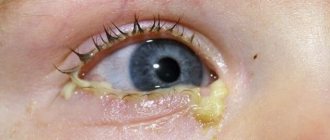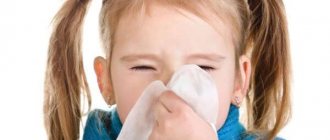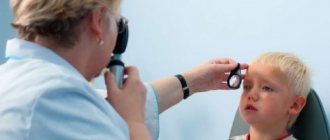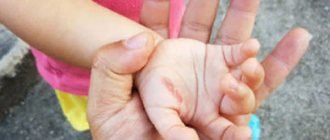Types of conjunctivitis in children
Conjunctivitis of various etiologies is among the most common ailments in children.
In this article
- Types of conjunctivitis in children
- Allergic conjunctivitis
- Bacterial conjunctivitis
- Dacryocystitis
- Treatment of bacterial conjunctivitis in infants under one year of age
- Treatment of viral conjunctivitis in children
- Prevention of childhood conjunctivitis
The causative agents of the disease spread through household contact and airborne droplets, and infants in the first year of life still have very weak immunity and are not able to sufficiently resist infections. Viral infection can occur when visiting a public place, from parents, while bacteria from dirty hands easily enter the mucous membrane of the eyes. Depending on the cause that caused the development of conjunctivitis in a child under one year old, several types are distinguished.
- Allergic. Eye inflammation develops when the conjunctiva is irritated by various substances. At this age, this most often occurs, for example, when introducing a new type of food. Allergies can also occur to medications, hygiene products, and insect bites.
- Bacterial. The most common type of conjunctivitis in children, which they often become infected with from a sick mother during childbirth (blennorrhea of newborns, chlamydial conjunctivitis), as well as when various microorganisms get into the eyes.
- Viral. It is provoked by various microorganisms, in particular adenoviruses, enteroviruses, etc.
- Dacryocystitis. Occurs due to obstruction of the lacrimal canaliculus. This eye pathology can be treated quite successfully with timely measures taken.
A common symptom for all types of eye inflammation is redness and swelling of the inner lining of the eyelid, but each of them also has its own characteristics. Let's look at the causes and symptoms of various types of conjunctivitis, as well as dacryocystitis in babies under one year old.
Allergic conjunctivitis in a 6-month-old child
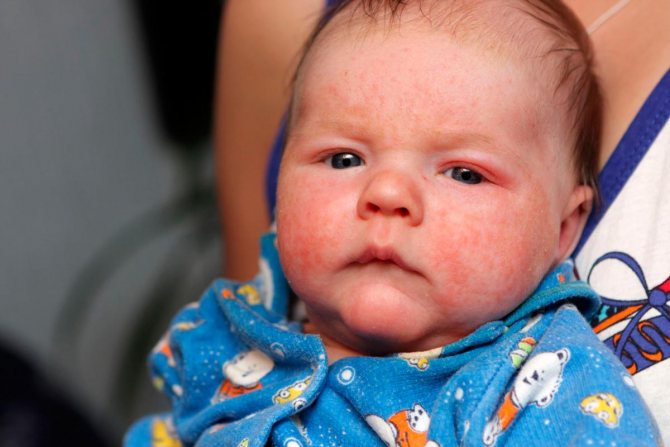
Allergies appear very quickly. In some cases, the first signs appear within 1-2 hours after a person comes into contact with the allergen. A typical sign of any allergic conjunctivitis is unbearable itching. The child will not say this, but you can observe his behavior. He constantly squints, rubs his eyes with his hands, cries, and sleeps restlessly. Another characteristic sign of this type of inflammation is lacrimation. Pus and mucus are not observed. If discharge of this nature appears, most likely, bacterial conjunctivitis develops in parallel with the allergy.
An allergic reaction is treated with antihistamines. Children, as a rule, are not prescribed glucocorticosteroids. They are very powerful. The need for them arises only in severe inflammation.
Allergic conjunctivitis
For very young children this phenomenon is quite rare. Typically, allergic inflammation can occur as a reaction to a new product in the diet or to an inappropriate medicine. With an allergy, profuse lacrimation appears, the eyes become red and swollen, the baby begins to worry and rub them. In case of an acute reaction of the body, Quincke's edema, urticaria and other complications may occur. For the treatment of allergic conjunctivitis, children under one year of age are prescribed drops that relieve swelling and irritation, for example, Vizin, as well as antihistamines Allergodil, Alezastin, Olopatadine. They help reduce the symptoms of the disease.
Viral conjunctivitis
This disease develops when various viruses enter the body:
- adenoviruses;
- herpes simplex viruses;
- Coxsackie viruses;
- enteroviruses, etc.
Quite often, conjunctivitis occurs against the background of colds - ARVI and influenza. Viral diseases spread very quickly through airborne droplets. Parents should be especially careful during periods of mass epidemics of these diseases and should not visit public places with their children unless absolutely necessary. Here are the symptoms of conjunctivitis in children under one year old that may indicate this disease:
- redness and swelling of the conjunctiva;
- irritation and itching in the eyes, the baby constantly rubs them and shows anxiety;
- profuse lacrimation;
- negative reaction to light;
- enlarged lymph nodes near the ears.
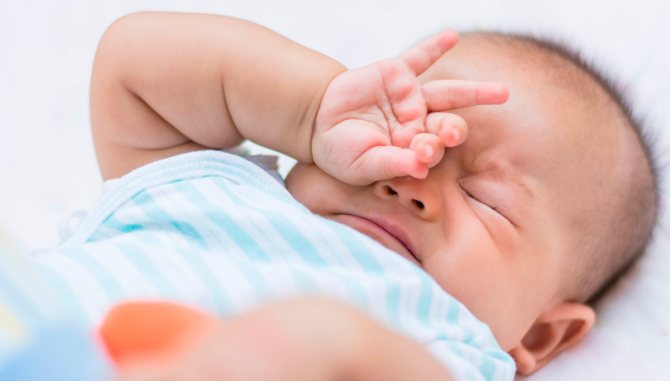
External signs of viral inflammation are quite similar to the manifestations of allergic conjunctivitis. If such symptoms appear, you should promptly visit a doctor or call him at home. Only after diagnosis will the ophthalmologist be able to find out the true cause of the disease and prescribe the necessary treatment. For the treatment of conjunctivitis in children under one year of age, anti-inflammatory drops and ointments approved for use at this age are prescribed. Independent choice of medications can negatively affect the child’s health.
Causes
Bacterial conjunctivitis is caused by:
- infection in the mucous membrane of the eye;
- facial injuries;
- ENT diseases with the formation of pus: sinusitis, tonsillitis, otitis media, etc.
In children's groups, the disease spreads quickly due to the fact that in the absence of clinical manifestations, it is difficult to identify the sick, and they continue to attend the educational institution.
Important! Children who do not have symptoms of conjunctivitis, but are in the incubation period , are also sources of infection for others.
Viral conjunctivitis occurs as a result of damage to the body by the corresponding pathogen: influenza, ARVI, enterovirus, adenovirus, chickenpox, measles, etc.

An allergic disease develops as a result of contact with a specific allergen.
This can include food, household chemicals, pets, dust, chemicals, pollen and much more.
Common factors contributing to the onset of the disease include:
- reduced immunity;
- hot, dry air in the room where children are;
- too bright light;
- insufficient hand hygiene;
- habit of touching eyes, face;
- deviations from the daily routine;
- errors in nutrition.
Bacterial conjunctivitis
It develops when pathogenic bacteria enter the body: gonococci, staphylococci, chlamydia, etc. The main symptom of bacterial conjunctivitis is purulent discharge from the eyes, while with allergic and viral inflammation it is clear or mucous. The pus often causes the baby's eyelashes to stick together, especially after sleep. With some forms of bacterial infection, such as chlamydia, the lymph nodes may become enlarged. If you do not promptly treat bacterial conjunctivitis in a child, it can become chronic, and then it will take a lot of time for a complete recovery. In addition, untimely treatment can lead to severe ulceration of the cornea and even loss of vision. To eliminate the symptoms of purulent inflammation, drops and ointments with antibiotics are used - they are prescribed by a doctor in accordance with the age of the child. In addition, it is necessary to wash the eyes several times a day with some antiseptic solution to mechanically remove the pus.
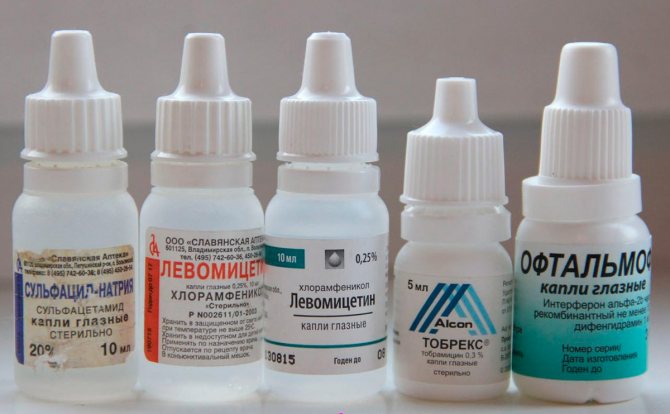
Treatment of conjunctivitis
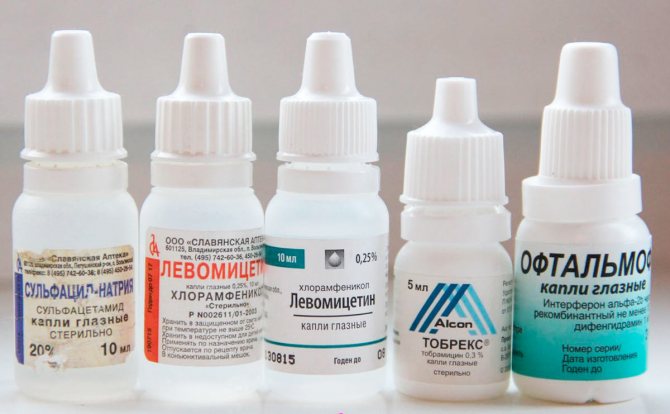
In many cases, conjunctivitis in children and adults goes away on its own, without special treatment. The following home remedies and over-the-counter treatments may be helpful to relieve symptoms:
- Gently wipe away discharge from the eye with a clean cloth, sterile swab, or cotton wool soaked in water.
- Applying lubricating eye drops called artificial tears, which are available without a doctor's prescription, to the eye
- Apply a cold or warm compress soaked in water to the eye
- Avoid rubbing your eyes as this may make symptoms worse.
- Avoid wearing contact lenses and makeup until the conjunctivitis resolves
- In case of allergic conjunctivitis, avoid exposure to allergen such as dust
In severe cases of conjunctivitis, eye drops and other medications may be recommended, such as antihistamines for allergic conjunctivitis, antibiotics for bacterial conjunctivitis, and antiviral drugs for viral conjunctivitis. Sometimes a person is referred for treatment to an ophthalmologist or ophthalmologist.
Good to know: eye drops, including those used to treat conjunctivitis, have an expiration date set for a certain period after they are first opened. Because the effectiveness of ingredients, including preservatives, may be reduced after the expiration date and harmful bacteria may enter the container, it is important not to use eye drops after the expiration date. It is also important not to share eye drops with other people. Always follow the instructions included with the eye drops regarding how to use them, as well as how to properly store them, which may include storing them in a cool, dry place or in the refrigerator.
Dacryocystitis
A common disease among children in the first year of life. Its signs appear 6-10 days after birth. If treatment is not treated in time, dacryocystitis can progress to the chronic stage. The cause of this eye pathology is the obstruction of tears through the lacrimal canal, which is clogged with pieces of embryonic tissue. Microorganisms accumulate there, and as a result, purulent inflammation of the eyes develops. Based on its external symptoms, dacryocystitis can be confused with bacterial conjunctivitis, but additional means must also be used to eliminate it. Thus, an important point in the treatment of dacryocystitis is massage of the lacrimal sac, located at the inner edge of the palpebral fissure. It is necessary to remove accumulated pus. This massage is best done after feeding the baby during the day. Place your index finger near the inner corner of the eye and move it towards the baby's nose with a slight but gentle force. It is necessary to make approximately 6-10 such movements. In this case, pus should come out of the lacrimal sac - confirmation that the massage is being carried out correctly. After its completion, you need to rinse the eyes with antiseptic solutions, and then introduce antibiotic drops. These procedures need to be repeated for two weeks - usually during this time it is possible to clean the canal; it is important to do this regularly. If massage does not help, mechanical cleaning of the tubule is prescribed.
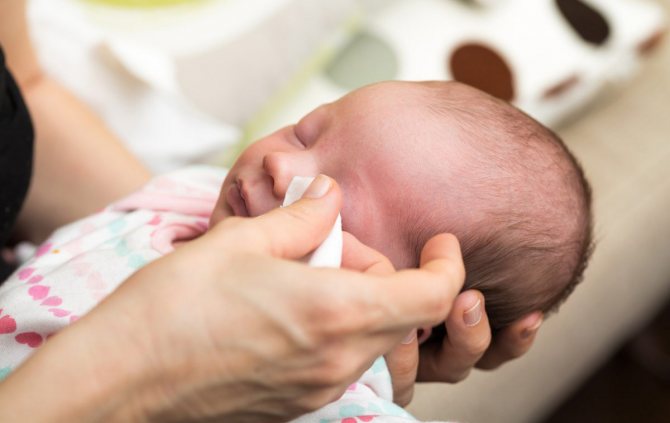
Treatment of bacterial conjunctivitis in infants under one year of age
For each type of pathology, their own medications are used. To diagnose the causative agent of the disease, the doctor takes a smear from the conjunctival cavity and then determines its sensitivity to various antibiotics. Only after this does he prescribe antibacterial drugs for the eyes.
"Albucid"
The most common eye drops for children of any age, starting from birth, which effectively eliminate the symptoms of the disease. They contain sulfonamide, an active antimicrobial substance. "Albucid" is also used to treat blenorrhea and purulent ulcers.
"Tobrex"
The active ingredient is tobramycin. This is a strong antibiotic that suppresses protein synthesis in the cells of microorganisms, disrupting their active functioning. Copes with most pathogens of bacterial conjunctivitis. Adverse reactions such as allergies and urinary disorders are possible. In case of such phenomena, you should consult a doctor to change the medicine.
"Vigamox"
The active ingredient is moxifloxacin 0.5%, which belongs to the fluoroquinolones and has an extended bactericidal effect. If there is severe discharge of pus, you can use an additional antibacterial ointment, for example, Erythromycin 1%. It has proven its effectiveness in forms of the disease that are difficult to treat (fungal, gonococcal, diphtheria and others). The ointment should be used after administering all the drops three times a day for 7-10 days, after which see a doctor.
How to treat inflammation
There are several methods of treating conjunctivitis, which are best used in combination to achieve greater effectiveness.
Washing
To treat bacterial and viral , eye washes with furatsilin solution, chamomile infusion, and strong brewed black tea .
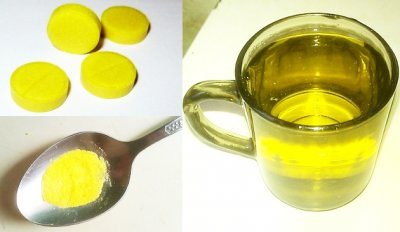
For allergic conjunctivitis, rinsing is not necessary .
Furacilin solution is prepared at the rate of 1 tablet per 100 ml of boiled water at room temperature. To infuse chamomile, it is better to take a filter bag and pour a glass of boiling water over it, let it brew for 15 minutes , then cool.
Tea is prepared in the usual way: half a liter of boiling water is taken for 1 tablespoon of tea leaves.
Washing is done as follows:
- a sterile napkin or clean cotton pad is moistened in the prepared solution;
- the eye is rubbed from the temple to the inner edge - it is advisable to perform the movement once, trying to immediately remove the discharge from the eye;
- The same napkin cannot be reused; a clean piece is taken for the second eye.
In the first days of illness, you can wash your eyes every 2 hours . In the future, it is enough to do this 3-4 times a day. Store the composition at room temperature for no more than 8 hours.
Massage
One of the methods that speeds up the treatment of conjunctivitis is massage of the nasolacrimal duct area . This procedure allows you to quickly remove discharge from the bacterial form of the disease, as well as in the case of viral conjunctivitis with an associated bacterial infection.
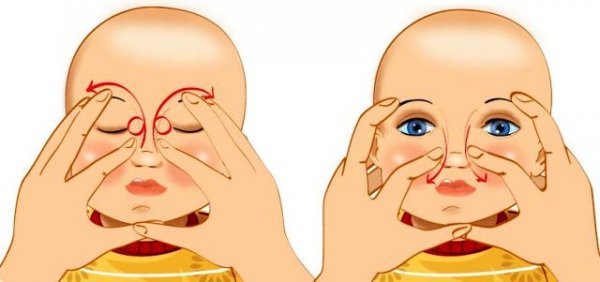
Photo 1. Scheme of performing a massage of the nasolacrimal duct in a child. Stroking should be done in the direction of the arrows.
Children 5-7 years old tolerate this procedure well. It is carried out immediately after washing the eyes.
Attention! Mom or another adult acting as a massage therapist should take care of the condition of their hands. No long manicure is allowed due to the risk of injuring the child’s skin. Wash your hands, dry them and treat them with an antiseptic, for example, Miramistin.
The essence of the procedure is to apply pinpoint pressure to the area located near the nasolacrimal duct, just above the characteristic tubercle. It should be pressed gently for one to two minutes . In this case, pus may come out of the eye; it should be removed with a sterile cloth soaked in a furatsilin solution. The procedure is carried out up to 5 times a day. After the massage, the appropriate medication should be dropped into the eyes.
Medicines for conjunctivitis
The use of medication is an indispensable element in the successful treatment of conjunctivitis.
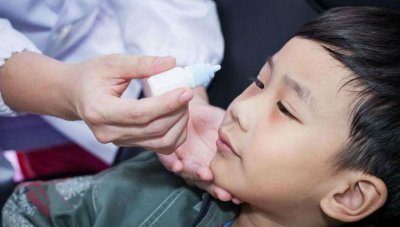
Eye drops and ointments with an antibiotic or antiviral effect are prescribed for bacterial and viral forms of the disease.
For allergic conjunctivitis, the main remedies are antihistamines and avoidance of contact with allergens.
Drops
The following medications are used for bacterial conjunctivitis:
- chloramphenicol drops;
- Tobrex;
- Fucithalmic;
- Phloxal.
1-2 drops of the drug are instilled into the eyes after rinsing and massage 2 to 4 times a day. Use the drug until the signs of the disease disappear and then for another two days.
For viral conjunctivitis the following are used:
- Aktipol;
- Trifluridine;
- Poludan;
- Interferon alpha-2.
A drop of the prescribed drug is instilled into the eyes 8 times a day in the first days of the disease, then 3-4 times until complete recovery.
Reference. For all forms of conjunctivitis, the drug Albucid is universally suitable. It washes the eye, removing pathogenic flora, viruses and allergens, disinfects and moisturizes the mucous membrane.
Ointments
For bacterial types of pathology in children 5-7 years old, erythromycin, chloramphenicol, ofloxacin ointments, Tobrex, Eubetal .
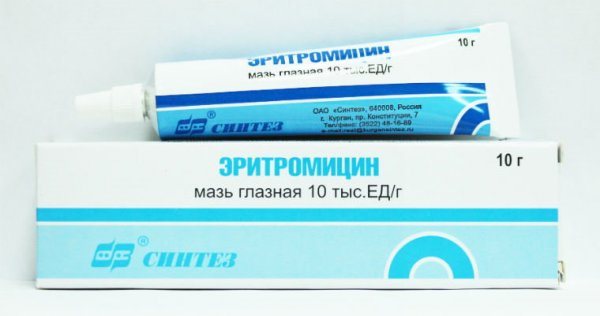
Photo 2. Packaging and tube of erythromycin ophthalmic ointment with a dosage of 10 thousand units/g, weighing 10 g.
For viral infections - oxolinic, Zovirax, Acyclovir, Bonafton. The drug in an amount of approximately 0.2 g (about the size of a small pea) is placed under the child’s lower eyelid 2-3 times a day until complete healing.
Treatment of viral conjunctivitis in children
Viral pathology usually develops against the background of ARVI or influenza. and in both eyes at once. Outbreaks of viral conjunctivitis often develop into epidemics. Antiviral drugs are used to eliminate the symptoms of this disease in children.
"Ophthalmoferon"
Their active ingredients are recombinant interferon 2-alpha and diphenhydramine - thus, antiviral and antihistamine effects are achieved simultaneously. For the treatment of children under one year of age, it is advisable to use Oftalmoferon when the first signs of the disease appear.
"Poludan"
A drug that enhances the synthesis of interferon, which significantly reduces the manifestations of viral eye inflammation in children. The main substances in these drops are polyadenylic and polyuridylic acids. The recommended dose for instillation is 1-2 drops three to four times a day. Already on the third day after starting to use Poludan, improvements in the condition are noticeable, irritation, redness of the eyes, and lacrimation disappear.
"Aktipol"
Antiviral drops that produce interferon in the body, which helps to significantly strengthen its own immune defense. The use of this medicine helps eliminate swelling and redness of the conjunctiva, reduce itching and irritation. "Aktipol" also has a keratoprotective effect, promoting the healing of corneal tissue. Since the product is applied topically, the main active ingredient - aminobenzoic acid - is well absorbed, contributing to a rapid therapeutic effect.
General principles for the treatment of conjunctivitis in a 6-month-old child
For almost all types of inflammation of the conjunctiva, drops with a moisturizing and lubricating effect are used - “Systane”, “Artificial tear”. They do not contain preservatives and are suitable for everyone. With conjunctivitis, lacrimation is usually a consequence of dry cornea. The eye begins to produce large amounts of tear fluid to get rid of this irritating symptom. Moisturizing solutions help eliminate dryness. Itching and burning also disappear. The child becomes noticeably better and can sleep peacefully.
When treating a small patient, great attention should be paid to the eye rinsing procedure. An antiseptic solution can be prepared from Furacilin. The tablet must be crushed into powder and dissolved in warm boiled water. You should get a yellow liquid. Since Furacilin always produces sediment, it is recommended to strain the solution. After this, soak cotton wool in it and gently wipe the baby’s eyelids, removing pus and crusts. Washing is carried out several times a day as mucus or purulent exudate appears. It is better to discard the solution that is not used during the day. The next day you can prepare a new one. These tablets are cheap. Both eyes are always washed, even if the inflammation affects only one of them.
Rules for administering drops and ointments
Before starting procedures, you should wash your hands. Before starting the instillation procedure, you need to wash the baby's eyes with antiseptic solutions to remove any remaining pus. These can be weak solutions of boric acid, furatsilin, etc. Take a separate cotton pad for each eye. When administering drops, make sure that the tip of the bottle dispenser does not touch the mucous membrane and skin around the eyes, so as not to spread the infection. Administer exactly the dose of medication prescribed by your doctor. After completing the procedure, you need to blot the area around the eyes with a clean napkin and wash your hands again. Medicinal drops and ointments are effective means for eliminating the symptoms of conjunctivitis in children. They have a local effect without penetration into the bloodstream. The drugs fight pathogens, performing antibacterial and anti-inflammatory functions. With the correct selection of medicine and following the doctor’s recommendations, the disease can be cured in 7-14 days.
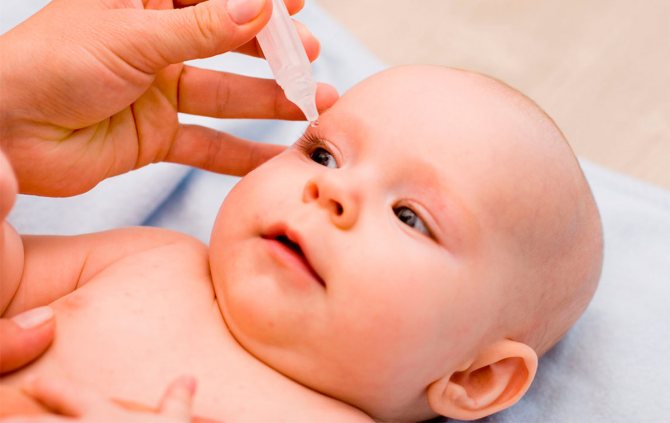
Prevention of childhood conjunctivitis
To prevent bacterial conjunctivitis in children under one year of age, a woman should take care of her health even before the baby is born. She needs to undergo a full examination by a gynecologist and cure sexually transmitted infections, if any. This will help protect the newborn from chlamydial conjunctivitis and blenorrhea. After the birth of a baby, special attention must be paid to the sterility of objects and hygiene products used to care for him. Bacterial infections quickly spread through household contact, as germs easily reach mucous membranes from insufficiently clean hands. It will be useful to ventilate the room, walk with the child more often, and perform water procedures, strengthening his immunity. Always keep the room clean and wet-clean surfaces more often to minimize the risk of infections. During periods of epidemic outbreaks of viral diseases, it is better to maintain a home regime, not visiting public places with your child unnecessarily.

Prevention
Preventive measures come down to simple but regular actions:
- Thoroughly wash every day with cooled boiled water; carry out preventive washing with chamomile decoction several times a week
- Preventing child contact with unwashed hands of adults.
- Providing the baby with personal hygiene products , including a separate towel.
- Ventilate the room and take daily walks in the fresh air.
- In some cases, as a preventative measure, the doctor prescribes additional medications to strengthen the immune system , but in no case are such medications taken without permission.
What is the danger of conjunctivitis?
Conjunctivitis in babies under one year of age can be successfully cured with timely consultation with a specialist and initiation of therapy. Self-therapy at home is strictly unacceptable. If conjunctivitis is suspected, a small child should be examined by at least two doctors - a pediatrician and then an ophthalmologist.
If symptoms of conjunctivitis appear in children, you should not use advice gleaned from forums on the Internet. The external manifestations of various ophthalmological diseases can be very similar, and only a specialist will be able to determine the true cause after taking the appropriate tests. Successful treatment of conjunctivitis in a child under one year of age depends on following all the specialist’s recommendations. It will be much more difficult to cope with an advanced disease. In addition, inflammation of bacterial or viral etiology can seriously harm the baby’s vision. In general, this visual ailment is not dangerous. With timely medical care, there is no threat to the visual organs.

